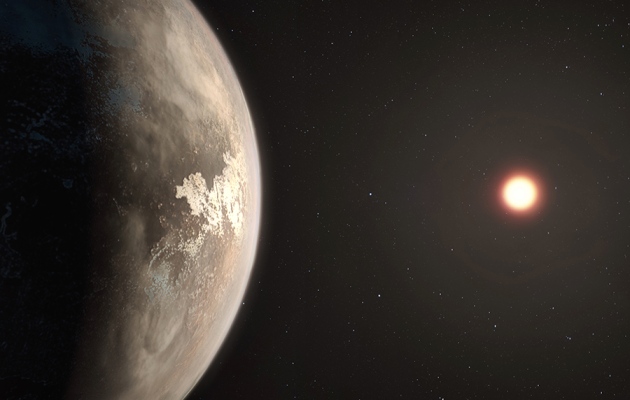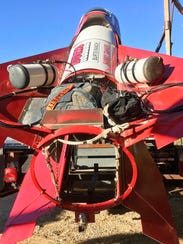...this back flipping robot has made recent headlines as of late and I thought that I'd post the video of it and the article accompanying it because as in the last video... I can see these robots walking on Mars etc alongside Astronauts and helping them to do experiments etc (or have I seen too many Sci-Fi movies perhaps?) lol!... anyhow... watching the early robots falling over is quite humorous but as you see in one of the clips they can now pick themselves up showing us just how advanced they are now... I find it all to be simply amazing... from this website below... cheers.
https://www.theverge.com/circuitbreaker/2017/11/17/16671328/boston-dynamics-backflip-robot-atlas
______________________________________________
One small backflip for a robot is one giant leaping backflip for humankind
by Paul Miller@futurepaul Nov 17, 2017, 5:16pm EST
Something that often bothers me about sci-fi is the loner inventor trope. A guy in a garage builds a robot, or AI, or frequently both that are somehow decades beyond the technology of his day, and all the wild implications of his vast technological leap are the fuel for the next two and a half hours of popcorn entertainment.
But the latest video from Boston Dynamics is the closest equivalent I've ever witnessed IRL. Sure, it’s the achievement of an entire company, and they’re doing it on YouTube for everyone to see, not in a basement. But a backflip?
It’s hard to even appreciate how hard this is for robots to do, because it’s hard to appreciate how difficult walking still is for humanoids. I wrote a whole piece about the problem of building walking robots back in 2011 — it wasn’t pretty back then, and it’s still a challenge for most full-sized humanoids.
A backflip though?
It's a barely-believable jump forward for the state of the art. It's astonishing. It's a moon landing, basically, except instead of all of the people of Earth gathering around tube televisions to witness it, it just popped up on our social feeds yesterday afternoon without warning.
Let's get a bit of historical context. Eleven years ago we were laughing as Honda's Asimo robot fell off a set of stairs.
In 2015, here's how far we'd come:
Yeah, we were challenging humanoid robots with much more complicated, dynamic, and demanding tasks than a staged ascent of a perfectly level set of shallow steps. But if you asked me, "How long until these robots are doing backflips?" in 2015, after a weekend of watching DARPA pratfalls, I would've frowned and said something like, "Ugh."
Would we have to develop some new form of organic mechanisms, more akin to the human body, to get the power / weight ratio just right? Would we have to rebuild software engineering from scratch to combine realtime responsiveness with machine learning complexity? Would we end up in some economic recession or war that would require the companies and institutions investing in humanoid robotics to stop wasting money and just ship something boring and useful?
I guess I could have said, "Maybe a decade. We have to figure out jumping first, and also running and walking." But "a decade" in the technology world means, "I literally have no idea."
And I guess I would've been right about one thing: I had no idea.
In 2016, not too long after the DARPA challenge, where many of the robots in the competition were based on Boston Dynamics' best-in-class Atlas humanoid, Boston Dynamics hit us with a new YouTube video: "Atlas, The Next Generation." The video showcased a much lighter and more agile version of the robot opening a door, walking through snow, picking up boxes, and getting hit with a hockey stick for no reason. It was a big improvement over the previous generation.
"When will it do backflips, Paul?"
"Um, a decade?"
Earlier this year, Boston Dynamics introduced an all-new robot called Handle with a four foot vertical jump. But it was a wheeled robot, and while impressive, wheels are vastly simpler than biped locomotion. What Handle proved is that Boston Dynamics could blast enough power through its hydraulics to generate the necessary force for lift-off. So all we needed was a few years of software improvements to get the balancing algorithm just right, and we could finally have jumping robots.
But yesterday, Atlas jumped on video. It leaped from box to box like a gazelle. It did a 180. And it did a backflip.
A humanoid strong enough to jump like that is capable of any "typical" human locomotion. Stairs, curbs, uneven ground, accidental jostling, sitting down, standing up, getting in and out of cars, subway lurches... all moves which are frequently performed by humans who can't land a backflip, and who get mad if you shove them with a hockey stick.
A backflip is a marvel of mechanical engineering and software control. It's a statement of power and poise. It's bonkers.
I'm certain there's still much more to do on the software side. Performing powerful jumps in a controlled, measured environment is easier than doing dynamic, improvisational parkour. And then humanoids still have to be taught how to do something useful with their newfound physical capabilities. Also, other companies will have to catch up with Boston Dynamics — just because this is possible it doesn’t mean it’s easy. We’re still a ways away from having backflipping robots as next door neighbors.
But I think we're in a new robotic age now. There was a time before Atlas could do backflips, back when robots were for factories, bomb disposal, vacuuming, and the occasional gimmick, and none of the useful ones were humanoids. Now we're living in an era where humanoid robots are apparently as agile as we are. So what will they be used for? It’s time to get out the popcorn.
https://www.theverge.com/circuitbreaker/2017/11/17/16671328/boston-dynamics-backflip-robot-atlas
______________________________________________
One small backflip for a robot is one giant leaping backflip for humankind
by Paul Miller@futurepaul Nov 17, 2017, 5:16pm EST
Something that often bothers me about sci-fi is the loner inventor trope. A guy in a garage builds a robot, or AI, or frequently both that are somehow decades beyond the technology of his day, and all the wild implications of his vast technological leap are the fuel for the next two and a half hours of popcorn entertainment.
But the latest video from Boston Dynamics is the closest equivalent I've ever witnessed IRL. Sure, it’s the achievement of an entire company, and they’re doing it on YouTube for everyone to see, not in a basement. But a backflip?
It’s hard to even appreciate how hard this is for robots to do, because it’s hard to appreciate how difficult walking still is for humanoids. I wrote a whole piece about the problem of building walking robots back in 2011 — it wasn’t pretty back then, and it’s still a challenge for most full-sized humanoids.
A backflip though?
It's a barely-believable jump forward for the state of the art. It's astonishing. It's a moon landing, basically, except instead of all of the people of Earth gathering around tube televisions to witness it, it just popped up on our social feeds yesterday afternoon without warning.
Let's get a bit of historical context. Eleven years ago we were laughing as Honda's Asimo robot fell off a set of stairs.
In 2015, here's how far we'd come:
Yeah, we were challenging humanoid robots with much more complicated, dynamic, and demanding tasks than a staged ascent of a perfectly level set of shallow steps. But if you asked me, "How long until these robots are doing backflips?" in 2015, after a weekend of watching DARPA pratfalls, I would've frowned and said something like, "Ugh."
Would we have to develop some new form of organic mechanisms, more akin to the human body, to get the power / weight ratio just right? Would we have to rebuild software engineering from scratch to combine realtime responsiveness with machine learning complexity? Would we end up in some economic recession or war that would require the companies and institutions investing in humanoid robotics to stop wasting money and just ship something boring and useful?
I guess I could have said, "Maybe a decade. We have to figure out jumping first, and also running and walking." But "a decade" in the technology world means, "I literally have no idea."
And I guess I would've been right about one thing: I had no idea.
In 2016, not too long after the DARPA challenge, where many of the robots in the competition were based on Boston Dynamics' best-in-class Atlas humanoid, Boston Dynamics hit us with a new YouTube video: "Atlas, The Next Generation." The video showcased a much lighter and more agile version of the robot opening a door, walking through snow, picking up boxes, and getting hit with a hockey stick for no reason. It was a big improvement over the previous generation.
"When will it do backflips, Paul?"
"Um, a decade?"
Earlier this year, Boston Dynamics introduced an all-new robot called Handle with a four foot vertical jump. But it was a wheeled robot, and while impressive, wheels are vastly simpler than biped locomotion. What Handle proved is that Boston Dynamics could blast enough power through its hydraulics to generate the necessary force for lift-off. So all we needed was a few years of software improvements to get the balancing algorithm just right, and we could finally have jumping robots.
But yesterday, Atlas jumped on video. It leaped from box to box like a gazelle. It did a 180. And it did a backflip.
A humanoid strong enough to jump like that is capable of any "typical" human locomotion. Stairs, curbs, uneven ground, accidental jostling, sitting down, standing up, getting in and out of cars, subway lurches... all moves which are frequently performed by humans who can't land a backflip, and who get mad if you shove them with a hockey stick.
A backflip is a marvel of mechanical engineering and software control. It's a statement of power and poise. It's bonkers.
I'm certain there's still much more to do on the software side. Performing powerful jumps in a controlled, measured environment is easier than doing dynamic, improvisational parkour. And then humanoids still have to be taught how to do something useful with their newfound physical capabilities. Also, other companies will have to catch up with Boston Dynamics — just because this is possible it doesn’t mean it’s easy. We’re still a ways away from having backflipping robots as next door neighbors.
But I think we're in a new robotic age now. There was a time before Atlas could do backflips, back when robots were for factories, bomb disposal, vacuuming, and the occasional gimmick, and none of the useful ones were humanoids. Now we're living in an era where humanoid robots are apparently as agile as we are. So what will they be used for? It’s time to get out the popcorn.























